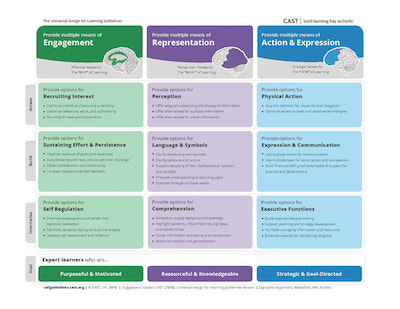Murph Kinney
The whole premise of this column is "getting better gradually." But this summer—since we will have to convert our Blackboard courses into the Brightspace platform—I am going to suggest that we, individually and collectively, make some larger leaps. I have three suggestions: applying any of them will serve to make your courses better, more inclusive, and approachable for students. The first is to think about the underlying structure of your courses. I remember when I was a doctoral student at Penn State. One member of my dissertation committee pulled me aside and told me to always claim I could teach any class that a department might ask me to. She said that the trick to being able to do that was to assign students the second-best textbook on the topic and then get the best textbook for that subject and base my lectures on that book. While initially I thought that might be good advice, over the years I've realized that sort of focus—on covering the content—really only serves to emphasize remembering concepts and facts, and does not easily lend itself to a transformational learning experience for students. One resource I've used for almost fifteen years now is Dee Fink’s Creating Significant Learning Experiences: An Integrated Approach to Designing College Courses. His work leads the reader through a series of exercises—thinking about the students who take the course, the place of the course in the overall curriculum and professional formation, the space in which the course is taught; assessing what the larger learning objectives are—what should students retain from the course a year after the end of the class; and selecting assignments which work with the content to adequately prepare students for purposeful assessment, both formative and summative. Going through this design process is not quick, but the payoff is a thoughtfully designed course, which supports students in reaching meaningful—and significant—learning objectives. A byproduct of this work will be a more engaging class, with transparent learning goals for students, and assignments that are appropriately scaffolded, learning to a greater likelihood of student mastery of the material. While the book is a terrific resource, Fink has also published on the internet a free self-directed guide for creating significant learning objectives which includes all the worksheets found in his book. The second suggestion I have for the summer is to familiarize yourself with Universal Design for Learning (UDL) and make plans to include UDL principles as you design your course in Brightspace (or for on-campus classes—UDL principles can be applied, well, universally!). What is UDL? It is a way of designing courses that are meaningful and challenging for all learners, taking into account "learner variability and mak[ing] instruction flexible and useful for all." The CAST website has an excellent infographic which illustrates UDL principles in three domains—student engagement, content representation, and communication of knowledge—and clicking on each component represented on the infographic will take you to a new screen which lists multiple ways of achieving each, allowing students to then select the ways to engage that makes sense to them. Before I had even heard of UDL, I was including short videos I found on YouTube to reinforce readings from the textbook (like this video on Otto von Bismarck), and my students were enthusiastic about being able to apprehend the course content through both text and video. UDL also encourages different means of assessment—for instance, allowing students to choose between writing a paper, creating a podcast or making an infographic. All three of these formats force students to research, select evidence and create an argument (or judgment), but in allowing students to choose their format, students are more invested in their project (and the same rubric can be used to mark the assignments with just a little tweaking). If you're interested in a deeper dive into UDL, Reach Everyone, Teach Everyone: Universal Design for Learning in Higher Education is a great read—and it speaks to the work of the college overall, not just in the classroom. It provides UDL adaptations that can be done in 20 minutes, 20 days, and 20 months—looking at both micro and macro adaptations. I don't suggest that you take on all three of these suggestions—but I would suggest that we collectively use this time of change in terms of learning management systems to think more deeply about the intent of our courses and how we can better engage our students. Any of these three ideas will help you do just that. If you take on one of these suggestions, let me know how it goes. You can reach me at murphk@fascc.org. |
